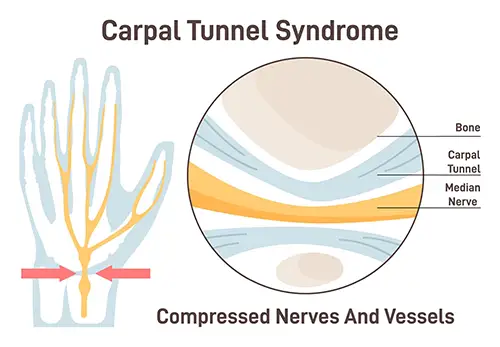Learn how to prove your carpal tunnel syndrome
is work-related so you can get the workers’ comp benefits you deserve
As technology continues to integrate into North Carolina workplaces, the risk of repetitive strain injuries like carpal tunnel syndrome (CTS) has increased significantly. This debilitating condition not only impacts a worker’s ability to perform their job duties but also makes everyday tasks outside of work challenging as well.
Fortunately, most workers in North Carolina are eligible for workers’ compensation if they can prove their carpal tunnel syndrome is work-related. Workers’ comp benefits can cover medical expenses related to treatment, lost wages, vocational rehabilitation, and more.
This article will delve into the risks of developing occupational CTS and explain how employees can prove their condition is linked to their job to secure the benefits they deserve.
What is carpal tunnel syndrome?
Carpal tunnel syndrome (CTS) is a condition where the median nerve in the wrist is compressed, leading to pain, numbness, and weakness in the hand and fingers.
The median nerve travels through a narrow passageway in the wrist called the carpal tunnel. This tunnel consists of bones and ligaments and provides a protective pathway for the median nerve and several tendons responsible for flexing the fingers.
CTS arises when the tissues surrounding the flexor tendons in the wrist swell or thicken, putting pressure on the median nerve. It often results from repetitive hand movements or prolonged wrist strain.

What are 5 symptoms of CTS?
Carpal tunnel syndrome can affect everyone differently, but some symptoms are more common than others. They include:
- Numbness or tingling. This typically affects the thumb, index, middle, and ring fingers. It’s often described as a “pins and needles” sensation, and it can interfere with daily activities by reducing hand sensitivity.
- Burning sensation. A feeling of burning is typical in the thumb, index, and middle fingers. This sensation can be persistent and uncomfortable, often affecting the ability to use the hand normally.
- Weakness. Weakness occurs most often in the hand and thumb, making it difficult to grasp or hold objects.
- Pain. Pain in the wrist and hand is most common, but it can also extend up the arm to the shoulder or down into the fingers. The pain is often more noticeable at night, disrupting sleep and causing discomfort throughout the day.
- Shock-like sensations. Some individuals may experience sudden, shock-like sensations radiating into the fingers. These unexpected jolts can be startling and painful, further hindering hand function.
If you experience any of these symptoms, it’s important to seek medical attention promptly to prevent the condition from worsening and to preserve hand function and quality of life.
North Carolina Workers’ Compensation for Pre-Existing Conditions
Learn if you’re eligible for workers’ compensation if you have a pre-existing condition.
What are the long-term effects of carpal tunnel?
Left untreated, carpal tunnel syndrome can lead to significant, long-term consequences. The most concerning outcome is permanent nerve damage, resulting in persistent numbness, tingling, and weakness in the hand. This can significantly impact daily activities and reduce hand dexterity.
Other potential long-term effects include chronic pain, muscle atrophy, and difficulty performing fine motor tasks. In severe cases, carpal tunnel syndrome can lead to permanent disability and a diminished quality of life.
Will CTS heal on its own?
Carpal tunnel syndrome typically does not heal on its own and may worsen over time if left untreated.
Early intervention with rest, activity modification, and non-surgical treatments like wrist splints and physical therapy can help manage symptoms. In severe cases, medical treatments or surgery may be necessary to alleviate the condition.
What occupations are at high risk for carpal tunnel syndrome?
Certain occupations are at higher risk for developing CTS due to repetitive hand and wrist movements, prolonged use of vibrating tools, and activities that require a strong grip or awkward hand positions. The workers most at risk of CTS include the following:
- Teachers and office workers
- Manufacturing and warehouse workers
- Construction workers, including roofers and flooring installers
- Health care workers
- Retail and grocery store workers, especially cashiers
- Delivery drivers and truckers
- Food processing workers and restaurant workers
- Military personnel
- Mechanics and technicians
- Musicians
- Craftsmen and artists
If you work in one of these high-risk occupations and experience symptoms of carpal tunnel syndrome, it’s important to seek medical attention and document your symptoms. Early intervention and proper documentation can help establish a link between your job duties and your condition, improving your chances of a successful workers’ comp claim.
Does workers’ comp cover carpal tunnel syndrome?
Yes, workers’ compensation can cover CTS if it can be proven that the condition is work-related, meaning that you must be able to demonstrate that your CTS is directly related to your job duties, such as repetitive tasks, the use of vibrating tools, or other contributing activities.
In North Carolina, most businesses with 3 or more employees are required to carry workers’ compensation insurance. Exceptions include agricultural employment with fewer than 10 employees, certain sawmill and logging operations, and domestic employees. Independent contractors are also typically ineligible for workers comp.
How to prove carpal tunnel is work-related
Proving that CTS is directly related to your job duties can be challenging because it worsens gradually over time, making it difficult to pinpoint the exact cause. This is compounded by the fact that health care providers don’t always recognize the association between CTS and someone’s occupation.
In fact, a study published in Health Science Reports found that clinicians did not inquire about the patient’s job in 60% of CTS cases. Even when the job was mentioned, no further assessment was made regarding specific tasks and activities.
Additionally, fewer than 10% of patients were referred to an occupational physician for further evaluation. This highlights the difficulty in establishing a connection between CTS and work duties, as some health care providers may not thoroughly investigate this link.
However, it’s not impossible to show that your work responsibilities caused your CTS. By compiling detailed information about your job duties and securing reliable medical evidence, you can increase your chances of proving the connection.
These key factors can help you obtain workers’ comp benefits for your carpal tunnel:
- Medical diagnosis and opinion. Get a confirmed diagnosis of CTS from an employer-approved doctor through exams and tests like nerve conduction studies. Also, obtain a written statement from your doctor linking your CTS to your job activities.
- Consistency of symptoms. Keep a diary of your symptoms so you can show that they align with your work activities and improve when you’re not working.
- Job duties documentation. Provide detailed information about your job tasks that involve repetitive motions, such as typing or using vibrating tools. Also, be sure to describe your work environment, focusing on any factors that could contribute to CTS, like poor ergonomics or lack of breaks.
- Witness statements. Gather statements from coworkers or supervisors who can confirm your job duties and any related health issues.
A workers’ compensation attorney can be essential to a successful workers comp claim for repetitive stress injuries like CTS. They can help gather necessary evidence and connect you with medical experts who can provide critical documentation and testimony to support your claim, ensuring you receive the benefits you deserve.
What Workers’ Compensation Benefits Are Available in North Carolina?
Learn about the 4 types of workers’ comp benefits you may be entitled to after a work-related injury, illness, or disease in NC.
How do I get workers’ comp in NC?
In North Carolina, obtaining workers’ compensation for a work-related injury or illness like carpal tunnel syndrome involves a specific process. The steps to file a claim include:
- Seek medical attention. Obtain medical attention to ensure your injury is properly documented. A thorough examination and detailed medical report are crucial for both your health and your workers’ compensation claim.
- Notify your employer. Inform your employer about your injury or diagnosis as soon as possible. North Carolina law requires that you report your injury within 30 days of the injury or discovery of the injury (date of diagnosis), but it’s best to do so immediately to avoid complications.
- File Form 18. Complete and submit Form 18 to the North Carolina Industrial Commission (NCIC) promptly, but no later than 2 years from the date of your injury.
- Await insurance response. The insurance company must provide written notice of their decision to accept or deny your claim within 14 days of receiving Form 18. This response will determine the next steps in your claims process.
To optimize your benefits and reduce stress, think about hiring a workers’ compensation attorney, especially if your claim is denied. An attorney can guide you through the process and help you navigate any disputes.
Get help from an experienced Charlotte, NC workers’ compensation attorney today
Workers’ compensation claims can be more complex than they initially appear. Engaging an attorney from the start can help you avoid a denied claim and secure the compensation needed for a full recovery.
With over 85 years of combined experience, the knowledgeable Charlotte work injury attorneys at Wilder Pantazis Law Group are dedicated to helping workers in North and South Carolina receive maximum compensation for their injuries. We provide free initial consultations and operate on a contingency basis, meaning you won’t pay a fee unless we help you recover compensation.
Contact Wilder Pantazis Law Group today for your free, no-obligation consultation to see how we can help maximize your claim.
References
Hassan, A., Beumer, A., Kuijer, P. P. F. M., & van der Molen, H. F. (2022). Work‐relatedness of carpal tunnel syndrome: Systematic review including meta‐analysis and GRADE. Health Science Reports, 5(6). https://doi.org/10.1002/hsr2.888



